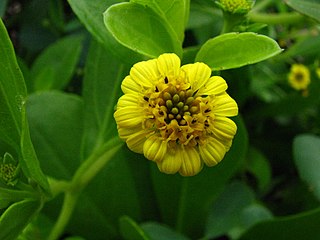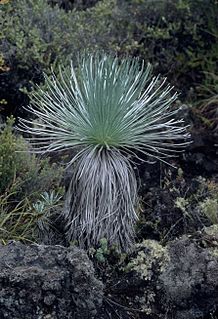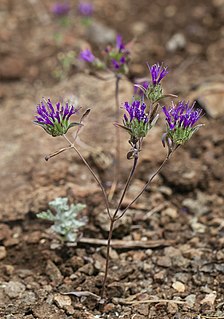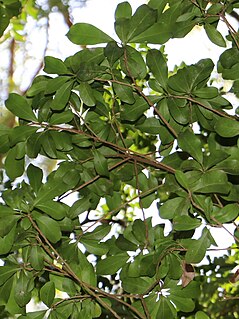
Kaʻena or Kaena Point is the westernmost tip of land on the island of Oʻahu. In Hawaiian, kaʻena means 'the heat'. The area was named after a brother or cousin of Pele. The point is designated as a Natural Area Reserve. Some ancient Hawaiian folklore states that Kaʻena Point is the "jumping-off" point for souls leaving this world.

Haleakalā National Park is an American national park located on the island of Maui in the state of Hawaii. Named after Haleakalā, a dormant volcano within its boundaries, the park covers an area of 33,265 acres, of which 24,719 acres is a wilderness area. The land was designated a national park in 1976 and its boundaries expanded in 2005.

Lipochaeta succulenta, the seaside nehe, is a plant endemic to all the main Hawaiian islands except Lanai.

Hibiscadelphus distans is an extremely rare species of flowering plant in the mallow family, Malvaceae, that is endemic to the island of Kauaʻi in Hawaii. It is known as hau kuahiwi in Hawaiian, which means "upland Hibiscus tiliaceus." It is a bush or small tree with heart-shaped leaves and yellow flowers and grows at between 1,000 and 1,800 feet in the remnants of native dry forests. Despite its rarity, it is believed to be the only surviving species in the genus Hibiscadelphus which is only known from Hawaii, the other five species having recently become extinct in the wild, some being known from only a single plant.

The Mauna Loa silversword, Argyroxiphium kauense, or Kaʻū silversword, is a rare species of flowering plant in the aster family. It is endemic to the eastern and southern slopes of Mauna Loa on the island of Hawaiʻi. A. kauense occurs in mountainous shrublands, bogs, and open mesic forest. The species is managed by the National Park Service and Hawaiʻi State Department of Forestry and Wildlife. It is a federally listed endangered species of the United States. There are three known populations remaining, for a total of fewer than 1000 individuals.

Schiedea adamantis, commonly known as Diamond Head schiedea, is a species of flowering plant in the family Caryophyllaceae, that is endemic to the island of Oʻahu in Hawaii. It inhabits low shrublands on steep slopes along the northwest rim of Diamond Head Crater. Associated plants include nehe, kāwelu, ʻakoko, and ʻilima. There are only about 30 individuals remaining, and they are threatened by habitat loss.

Lipochaeta, common name nehe, is a genus of flowering plants in the family Asteraceae that is endemic to Hawaii.

Monardella douglasii is a species of flowering plant in the mint family known by the common name Douglas' monardella.
Isodendrion hosakae is a rare species of flowering plant in the violet family known by the common names cindercone isodendrion and aupaka. It is endemic to Hawaii, where it is known from fewer than 1000 individuals on the island of Hawaii. It is a federally listed endangered species of the United States.

Melanthera fauriei, known by the common name Olokele Canyon nehe, is a rare species of flowering plant in the aster family.
Melanthera kamolensis, known by the common name Maui nehe, is a rare species of flowering plant in the family Asteraceae.

Lipochaeta lobata is a species of flowering plant in the family Asteraceae known by the common name shrubland nehe. It is endemic to Hawaii, where it can be found in coastal dry shrublands and dry forests on Oʻahu, Maui, and Niʻihau.

Melanthera micrantha, known by the common name Kauai nehe, is a rare species of flowering plant in the family Asteraceae.

Melanthera tenuifolia is a rare species of flowering plant in the family Asteraceae known by the common names Waianae Range nehe and slender-leaf nehe.
Melanthera waimeaensis is a rare species of flowering plant in the family Asteraceae known by the common name Waimea Canyon nehe. It is endemic to Hawaii, where it is known only from the island of Kauai. It is federally listed as an endangered species of the United States.
Lysimachia venosa is a rare species of flowering plant in the family Primulaceae known by the common name veined yellow loosestrife. It is endemic to Hawaii, where it is known only from the island of Kauai. The plant was only collected twice, last in 1911, but in 1991, a branch was discovered that had broken off the steep cliffs above the headwaters of the Wailua River. The branch was from a plant of this species and may have fallen from the summit of Mount Waialeale. No more specimens have been found since and the plant may be extinct, but some experts believe it may still exist in unsurveyed parts of the habitat. It was federally listed as an endangered species of the United States in 2010.
Schiedea attenuata is a rare species of flowering plant in the family Caryophyllaceae known by the common name Kalalau schiedea. It is endemic to Hawaii, where it is known only from the Kalalau Valley on the island of Kauai. It is threatened by the degradation of its habitat. It was federally listed as an endangered species of the United States in 2010.

Solanum incompletum is a rare species of flowering plant in the family Solanaceae known by the common names thorny popolo and popolo ku mai. It is endemic to Hawaii, where it occurs today on the islands of Maui, Lanai, and Hawaii. It is threatened by the destruction and degradation of its habitat. It is a federally listed endangered species of the United States.

Vigna owahuensis is a rare species of flowering plant in the legume family known by the common name Oahu cowpea.

Fontainea venosa, also commonly known as southern blushwood, veiny fontainea, Queensland fontainea and formerly named as Bahrs scrub fontainea is a rare rainforest shrub or tree of the family Euphorbiaceae. It is found in southeastern Queensland, Australia, extending from Boyne Valley to Cedar Creek and is considered vulnerable due to several contributing threats. The total population size is around 200 plants.















